
Do you have the goal to get lean and muscular?
You know the physique with ripped abs, broad shoulders, thick upper back, masculine chest, well developed arms and powerful looking legs?
Like the kind of physique Chris Hemsworth had in Thor or Henry Cavill in the movie Immortals.
But, at the same time, you don’t want to give up on living in the process. You still want to eat foods you like, you don’t want to live in the gym, and you don’t want to do hours of grueling cardio.
You know what, I completely agree. Why would you do more, when you can get just as good results from doing less?
Make sure you read to the end of this guide, as I’m going to show you the best dieting and training strategies that not only will get you in incredible shape, but also allow you to “have the cake and eat it to”!
Literally.
Table of Contents
You Can Get Lean And Muscular Fast & Easy Without Giving Up On Your Lifestyle!
First of all I want to make it totally clear:
It is entirely possible to get a lean and muscular physique without giving up on your life in the process. In fact, a lot of actors have successfully pulled this off.
For example, Hugh Jackman (Wolverine) is known to train rather minimalistically, with only a few workouts per week, and he’s incredibly ripped:

Mind you that Jackman has a lot of other work to do, such as rehearsing scripts and traveling to movie shoots all around the world. So, he pretty much needs to train minimalistically.
Another example is Greg O’Gallagher.
Greg’s known to eat 2-3 large satiating and satisfying meals per day, and he typically includes either a chocolate bar, some chips or alcohol during the evenings as well, all while looking like this:

Not only that, he’s also known to work out only 2-3 times per week for a total time of around 40 minutes per workout.
And these are just two examples out of maaaany!
In fact, I’ve devoted the past 4 years of my life building a decently ripped physique. And my main goal has always been to be able to live as much as possible while getting the results in the meantime. This mindset has allowed me to continue getting ripped even while traveling.
Here’s a full day of eating vlog that I created a few months ago:
And here’s what my training routine usually looks like:
- Monday – Upper Body (Chest Emphasis)
- Wednesday – Legs
- Friday – Upper Body (Back & Shoulder Emphasis)
So, as you can see, it’s entirely possible to achieve a lean and muscular physique without giving up on everything just to get it.
I’ve always been at the belief that it doesn’t have to be all black or white, and this or that. No, my view of mostly everything is that we can have it all, as long as we get resourceful enough.
And when it comes to diet and training, this means educating ourselves instead of blindly following the mainstreams fads and myths.
So, let’s do just that:
How To Get Lean And Muscular Without Giving Up On Your Lifestyle
Before moving on to the “without giving up on your lifestyle part” let’s briefly cover what needs to be done in order to get a lean and muscular physique.
In order to reach your goal physique, you’re going to have either one, or a combination, of these two goals:
- Goal #1: Getting down to a low body fat percentage
- Goal #2: Building a fair amount of muscle mass
It’s when you combine these two that you get that aesthetic physique. But I’m sure you knew that already.
But, where exactly do you start?
Well, where you start depends on where you currently are:
If you’re skinny, your goal is obviously to build a fair amount of muscle mass.
If you’re fat, your goal is obviously to get down to a low body fat percentage.
And if you’re somewhere in the middle, i.e. skinny fat, you should ideally get lean first before focusing on building muscle through bulking.
The skinny fat physique is a bit tricky to get out of in the beginning, but you can read more about solving the skinny fat dilemma here.
Okay, so no matter where you currently are and where you need to go, you’re going to need to set up your diet and training in some shape or form to reach the desired goal.
And here’s the thing:
The way you choose to set up your diet and training is going to make the difference between having to give up on your lifestyle or being able to enjoy your lifestyle even more.
When I say enjoy your lifestyle more, I simply mean that you set up your diet and training in a way that doesn’t interfere much, if any, with your current way of living, while you also get ripped in the process.
In fact, what you’re about to read from here on, applies to you who don’t want to spend ages in the gym just to come home to eat boring, monotonous meals day in and day out.
So, with that said, let’s get to it:
Setting Up An Enjoyable Diet
Okay, so what is an enjoyable diet?
Well, that’s somewhat of a tricky question to answer, because what’s enjoyable to one person might not be enjoyable to another.
However, there are two “rules” that must take place if you want your diet to be enjoyable no matter who you are, and these are:
- Results
- Adherence
These two rules are interrelated, which means that they help promote one another.
Let’s take a closer look at them one by one:
Rule #1: Results
Here’s the thing:
If your main goal is to either lose fat or gain muscle within a fairly short time, then you must alter your diet to focus on one of these goals separately.
And if the way you alter your diet gives you noticeable results, within a decently fast time frame, then that’s for sure going to be enjoyable. You agree on that right?
Now I’m sure you’re going:
Well, yes captain obvious!
But here’s the kicker:
Most dieting methods/fads out there, such as LCHF, Paleo, The GI method, GOMAD, Raw foods, Clean eating etc. typically provides fast results. However, all of these methods fail to take the second rule into consideration, which is:
Rule #2: Adherence
What do you think is the biggest problem with mainstream diets, like the ones mentioned above?
Well, that they’re all VERY restrictive.
And a very restrictive diet is hands down the biggest enemy towards having an enjoyable lifestyle.
Because, it’s only going to take you so long before you’ll start realizing that it’s not worth it having a lean and muscular physique, if you can’t maintain an enjoyable lifestyle in the meantime.
This will eventually lead you to fall of the wagon, and most likely quit with your goal of getting a lean and muscular physique.
For example, low adherence to dieting is the BIGGEST reason why more than 90 % of people return to the same level of fatness, or even higher, than before they went on a fat loss diet.
So, the question becomes, how do you fix this?
You Need To Connect Your Fitness Plan With Your Lifestyle
In order to align the two rules results and adherence, you need to connect your fitness plan with your lifestyle.
And this will only happen once you learn how to be in control over your diet, instead of letting the diet be in control over you. In fact, this is the only way to be successful long term!
So, how do you connect your fitness plan with your lifestyle?
Well, throughout my years in the fitness industry I’ve recognized that most people who’ve successfully gotten to a lean and muscular physique, while also keeping their lifestyle intact, typically uses the same dieting strategies.
In fact, there are three strategies that when combined together creates, at least what I believe to be, the most powerful dieting system in the world when it comes to getting lean and muscular without giving up on living a “normal lifestyle” in the process.
And here’s the system:
The Most Enjoyable Dieting System For Getting Lean And Muscular In The World
Here are the three strategies that combined forms an incredibly powerful dieting system:
- Counting calories and macros
- Flexible dieting
- Intermittent fasting
As you can see, these three are all about educating yourself to succeed. They’re not about removing a few simple ingredients from your diet and you’re all set for life, because it doesn’t work like that.
So, if you’re ready to learn how to take control over your diet, so that you can get the physique you’re after, while also enjoying your life in the process, then let’s quickly cover these three strategies:
Strategy #1 – Counting Calories And Macros
This is the most important strategy and it’s the one which lays the foundation for this entire dieting system.
You see, if you want to be in control over your results, it makes sense to focus on the things that actually matters, right?
And no matter if your goal is to lose body fat or build muscle, calories and macros matters most (#science):
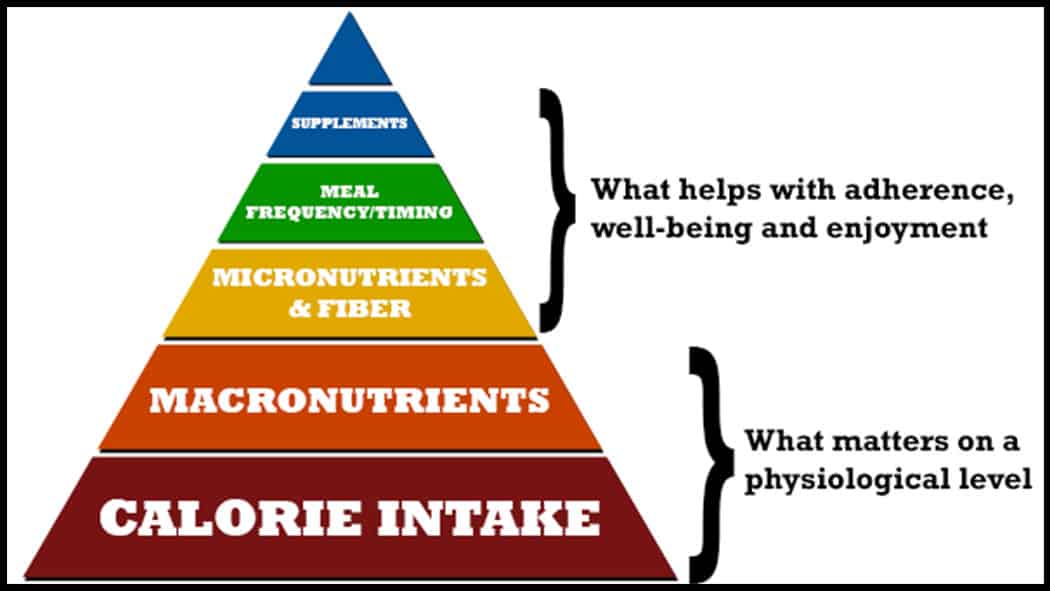
As you can see, this pyramid, which was introduced by Dr. Eric Helms, displays the scientific hierarchy of importance when it comes to dieting for changing body composition.
Where calories and macros are the two factors determining your results and what will happen on a physiological level. While the other three, micros, meal frequency/timing and supplements helps with adherence, well-being and enjoyment to the diet.
Benefits Of Counting Calories And Macros
The biggest benefit that comes with counting calories and macros is that you gain incredible control over your results.
When you learn how to count properly, you’ll quickly see just how easy it becomes to lose fat, if that’s your goal. Or gain weight (muscle), if that’s your goal.
This is perfect if you want to take advantage of bulking and cutting cycles, to rapidly reduce the time it takes to build a lean and muscular physique as well:
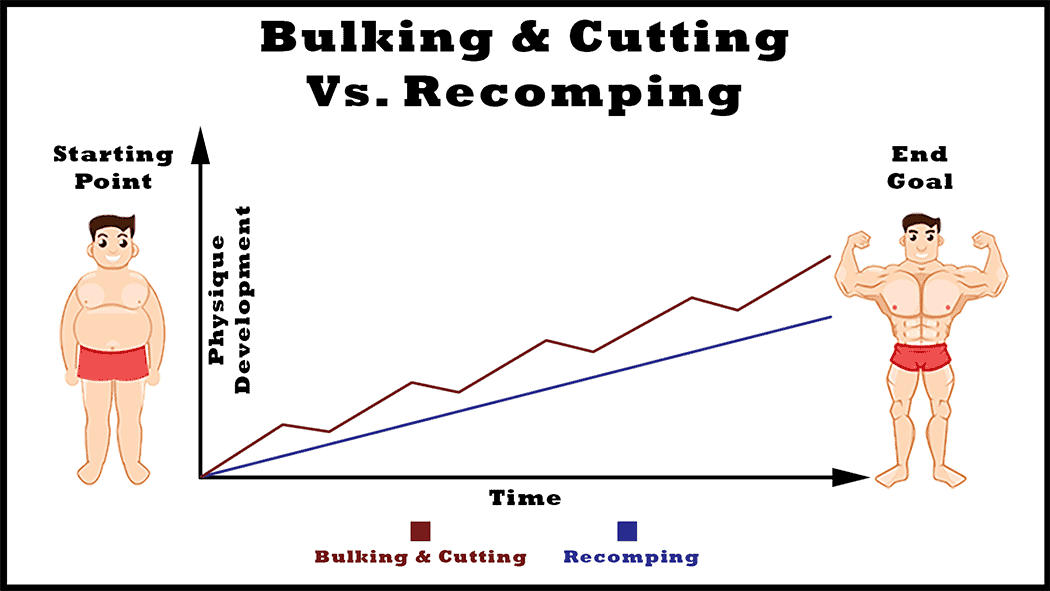
Another huge benefit that comes with learning how to count your calories and macros, is that you’ll start to notice that the energy and nutrients you need, can be viewed kind of like a budget.
Where as long as you reach a certain required nutrient intake, anything above this requirement can be foods that you enjoy, which is normally classified as “junk”, such as cookies, candy, chips and so on.
Yes, that’s right, you can include these things, while getting the results in the meantime. Which is something we’ll look closer at in a moment.
But, counting calories and macros just seems like a lot of extra work…
Well, I totally get it, in fact I felt the same in the beginning of my fitness journey.
But here’s the thing:
In order to transform your physique into one that’s lean and muscular, something’s gotta change, that’s just the name of the game.
Unfortunately, you can’t just press a button and you’ll look incredible. Perhaps you can one day in the future, who knows? 😉 But for now you can’t.

So, what I want to ask you is this:
Is that “something gotta change” going to be things that you enjoy in your life, without the certainty of actually getting the results? Which will happen if you keep trying different dieting fads instead of educating yourself.
Or is it going to be taking some time to learn a new skill that will allow you to get very predictable results, while allowing you to indulge in the things you enjoy as well? Which will happen by learning how to count your calories and macros.
Once I realized this, there was no doubt about it, taking the latter approach just made so much sense. So, I stuck to it for a few months, and before I knew it, it became a habit.
Getting lean and muscular is now very easy and predictable for me.
So, how do you do it?
How to Count Your Calories And Macros
I’m not going to go much in-depth on how to count your calories and macros in this post, as I’ve written a complete guide about it, which you can read here.
But just briefly, here’s the process:
1. Find Out Your Maintenance Calories (TDEE)
There are many confusing calculators out there for calculating TDEE. But I’ve found the following simple formula to work just as well:
- Body Weight in pounds x 14-17
- Body Weight in kilos x 31-37
Use the lower number if you’re sedentary, use the higher number if you’re very active, and pick a number in between if you’re moderately active.
*This will just be a starting number and will most likely need to be adjusted later.
2. Set Up Your Calorie Deficit or Surplus Depending on Goal
I don’t like to give a generic number when it comes to setting your calorie deficit or surplus, since that typically sets you up for poor results, so here’s what you should do:
- If your goal is to cut and lose fat, set your caloric deficit after current body fat percentage. And make sure you slow it down as you get leaner over time by using diet periodization.
- If your goal is to build muscle, set your caloric surplus after training experience (beginner, intermediate or experienced).
3. Set Up Your Macros
- Protein: 1.8-2 grams per kilo (0.8-1 gram per lbs) of body weight per day. Go higher when cutting and lower when bulking.
- Fat: 25-35% of total calories. Not as important, can vary from day to day.
- Carbs: The remaining calories. Not as important, can vary from day to day.
4. Start Counting Your Calories And Macros
Download an app like MyFitnessPal where you’ll have a food database that people all around the world adds to the app.
All you have to do is just search up the food that you intend to eat, or even use the built-in barcode scanner to scan the packages.
Then it’s just a matter of hitting your calories and macros consistently over time. And just like that you’re the one in complete control towards getting that lean and muscular physique.
Okay, so let’s look at the second strategy in the system, which is an extension of the first one.
Strategy #2 – Flexible Dieting

Did you know that The World Health Organization define health like this:
“A complete state of physical, mental and social well-being.”
This is interesting, as we often get told that we’ll achieve health once we reach a healthy BMI and/or body fat percentage. But, in reality, that’s just one third of the total equation for health.
So, the question becomes:
How do you achieve this? How can you set up your diet to have, not only physical, but also mental and social well-being?
Well, by taking a flexible and inclusive, instead of a strict and exclusive approach to dieting.
Because here’s the thing:
If you choose to go with the strict and exclusive approach, you could achieve a complete state of physical well-being. As you’d do so by limiting your food choices to only eat certain types of food that you deem “healthy”, which will then lead to physical well-being, i.e a healthier and leaner body composition.
Even though this approach is totally fine, and it’s a solid path towards a lean, muscular and healthy physique. What’s negative, is that it will limit your mental and social well-being.
Let’s look at how:
What you’ll read next is one of my favorite examples when it comes to demonstrating the advantage of taking the flexible approach to dieting:
Would you attend your mother’s birthday party and refuse to eat a piece of the birthday cake just to get a lean physique?
Look:
Social events happen and they’re a part of life, and I’m pretty sure that you love your mother more than what you enjoy having ripped abs and a lean body? Feel free to correct me if I’m wrong.
In my honest opinion, refusing to eat these things is not mental, and definitely not social well-being.
But, bare with me, it’s a rather easy fix, all it takes is a shift in your mindset:
Everything doesn’t have to be so black or white; you can in fact indulge in a piece of cake or two and still achieve a lean, healthy and muscular physique.
And the key to be able to do so is to learn strategy number 1:
Calorie & Macro Counting Allows For Flexible Dieting
The reason why counting your calories and macros allow you to include “junk” foods both when cutting and bulking, while seeing great results in the meantime, is this: https://www.ironbuiltfitness.com/junk-food-while-cutting
In the awesome book “Hungry Brain”, Stephan Guyenet went through some data showing the following:
In today’s age we consume the same amount of calories to what we did in the early 1900’s – at a time when overweight and obesity was extremely rare.
So, why are so many of us overweight and obese today when the average calorie intake is the same?
Well, because of these two things:
1. Physical activity
Back in the earlier 1900’s we simply walked more and sat less, which caused our calorie intake to “match” our calorie expenditure much better. This promoted a lean and healthy body composition.
2. The quality of food
The title of the book “Hungry Brain” has a lot to do with the impact that processed “junk” foods have on our brains.
When we’re eating processed foods, we simply have a really hard time stopping to eat.
In other words, when the food is natural it’s much easier to regulate calorie intake to what our body actually needs. But when the food is unnatural and processed, we lose that control.
And this is where calorie and macro counting comes into the picture. If you get into the habit of counting your calories and macros, it’s A LOT easier to control your junk food intake.
Essentially, you can have the cake and eat it to. Or in this case, have the lean and muscular physique, while enjoying yourself in the meantime.
If you know that you got 500 calories left to eat and you’ve hit the nutrients that you need for the day, then you can fill out these 500 calories with junk foods without any negatives on health and physique development at all.
So, you can with good conscience indulge in 500 calories of chocolate, chips, or whatever “junk” you’d like to include for the day, as long as you stick to that number, which you now have control over.
And just like that you’ve included mental and social well-being into the equation as well!
Your Diet Must Remain Healthy
There is one danger to the flexible dieting approach that’s important to address.
Since you’re controlling your food intake by counting your calories and macros, it’s very easy to start including WAY too much junk foods in your diet.
The belief that “well, since it fits my calories and macros, I can just eat whatever” is very common among practitioners of the approach.
If you’ve ever heard about the acronym IIFYM, which stands for If It Fits Your Macros, you know what I’m talking about.
IIFYM and Flexible dieting is basically the same thing. But I don’t like to use IIFYM because it creates the notion that it’s okay to eat whatever foods you like as long as you hit your macros, which it’s not!
No, in order to build a lean and muscular physique, while keeping your health and sanity, you must make sure your diet is also healthy.
A lot of people see the concept of flexible dieting (IIFYM) as being a freeway to eat tons of junk food.
But unfortunately, eating too much junk, such as ice cream, chocolate, candy, chips and so on won’t be sustainable long-term.
Because, even though calories and macros mainly are what determines fat loss and muscle growth in the short term.
In the long-term, you need a diet that contains a full spectrum of micronutrients, such as vitamins, minerals and fiber as well. If you don’t get these nutrients, your health, performance and eventually your physique will suffer from malnutrition.
So, how do you avoid ill-health while still getting the most out of your diet then?
Well, you follow something called:
The 80/20 Rule of Dieting
This is where you make sure that 80 % of your diet contain wholesome nutrient dense foods, and the remaining 20 % can be from lower quality foods.
Here’s a pyramid to keep in mind:
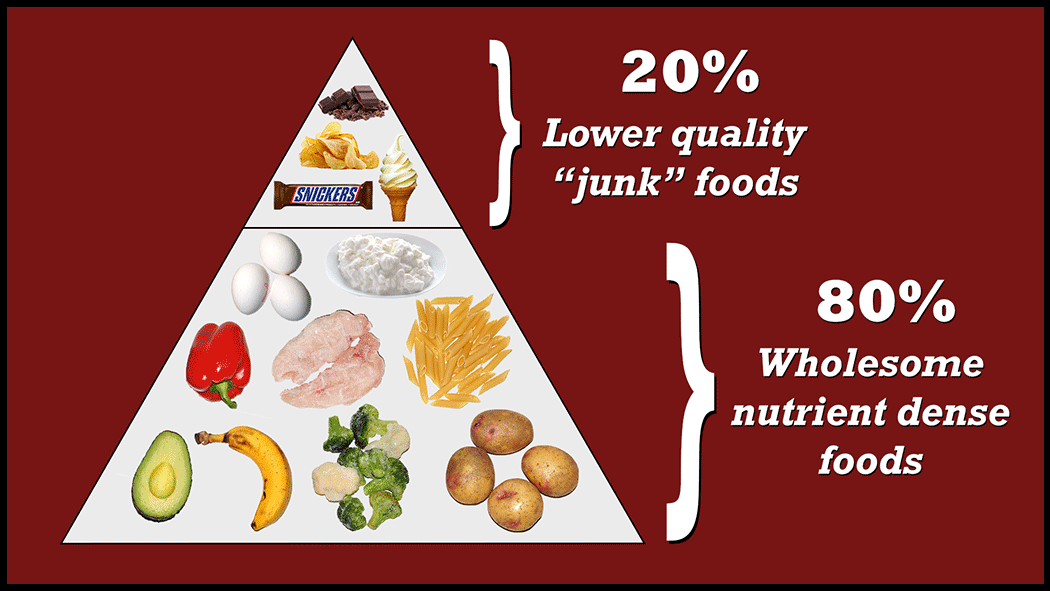
If you follow these guidelines, you will achieve a lot of dieting freedom, see incredible results with your physique, and feel great at the same time. You will achieve physical, mental and social well-being!
Okay so let’s look at the last strategy that really puts the icing on the cake when it comes to making getting lean and muscular incredibly enjoyable, which is to use:
Strategy #3 – Intermittent Fasting
Using intermittent fasting is the number one most beneficial strategy for optimizing satiety and satisfaction when cutting down to a low body fat percentage.
It’s also a great tool for preventing unnecessary fat gain when bulking to build muscle.
Let’s look at why:
What you take advantage of when using intermittent fasting, is creating a food budget for later in the day, simply by eating less earlier in the day, that’s basically it.
People seem to think that fasting is something magical which makes you get and stay lean. However, this is not entirely true.
To get lean and muscular, calories and macros is the name of the game, not how often you eat.
With that said though, the power of intermittent fasting lies in its ability to make being in a caloric deficit, required to lose fat, feel easier.
Or on the other hand, make it easier for some people to not overeat when being in a caloric surplus trying to gain muscle. This one is especially true for people starting with the fat or skinny fat physique.
Because here’s the deal:
Eating most of your food, including carbs, during the evening, is greatly beneficial on dieting adherence for most people, which will lead to great results further down the road.
And here’s a quick list of why:
1. Most People Find It Easier to Cut Back on Food Earlier as Opposed to Later in the Day
Don’t you agree that it’s easier to skip eating those cookies that lies in the cabinet during the morning than what it is during the evening?
2. Social Events and Gatherings Typically Take Place at Night
Having calories saved up for social events and gatherings makes dieting a lot easier. You no longer have to dread going to a party or eating out. Because with the help of fasting you made room for it!
3. Feasting During the Evening is Highly Beneficial on Well-Being and Satiety at a Time When it’s Typically Needed the Most
Here’s a quick question that I always ask people when they’re sceptical about trying intermittent fasting to help them get and stay lean:
What Would You Choose?
Option 1: Coming home from work, followed by a training session feeling drained, and knowing that you must resist eating food all night to stay lean;
or would you choose:
Option 2: Coming home from work, followed by a training session, this time feeling perhaps a bit more drained than option 1, but now you have a feast with family, friends or in front of your favorite TV-series to look forward to, all while staying lean?
4. Intermittent Fasting Saves You Time From Cooking and Eating Food
This might not be the biggest of benefits, but it sure has some merit, at least during the mornings.
Most people who try intermittent fasting for a while find that their productivity goes up during the earlier hours of the day. This is partly from the time they can now spend being productive instead of cooking and eating.
Okay, so fasting sounds good and all…
But, what about during the fast? Won’t that be tough? Not to mention hunger?
Well, after you get used to fasting (which typically takes around 2-3 weeks) you will actually start to notice the complete opposite effect!
Which is mental sharpness and blunted hunger. And this is the real power of intermittent fasting, and why it makes getting and keeping a lean and muscular physique so easy.
These effects take place after up-regulation of various hormones such as adrenaline, cortisol and growth hormone etc. that naturally occurs during the fasted hours.
And these hormones combined with low insulin levels (which also comes with fasting), puts the body in a state where it can effectively use its stored body fat as energy.
This process makes you burn more fat, simply because it gets extremely challenging to over consume food once you’re free to eat later in the day!
If you’re interested in setting up intermittent fasting, you can read all about setting up a good schedule in this post.
And also check out these 8 intermittent fasting tricks that’ll make your fast feel like a breeze.
Okay, so there you have it, the most effective and enjoyable dieting system that will definitely connect your dieting plan with your lifestyle.
If you want some inspiration for tasty and enjoyable fat loss meals, check out this post.
Let’s turn the page and look at training:
Setting Up The Most Bang For Your Buck Training Program
If your goal is to get a lean and muscular physique without spending ages in the gym, then aiming for the minimalist training approach is definitely the way to go.
What do I mean by minimalist training?
Well, minimalist training is the least amount of training that you can do, while still getting the best results possible.
It’s quick, it’s effective and it’s efficient.
So, let’s look at the most optimal training system that will get you lean and muscular without draining your lifestyle.
The Minimalist Training System
In this system there are four key strategies that when combined gives you the most bang for your buck, and these are to:
- Train 3-4 times per week
- Train with compound exercises
- Train in the 5-12 rep range
- Train with MYO-Reps on a few key isolation exercises
Let’s take a brief look at these one by one:
Strategy #1 – Train 3-4 Times Per Week
This is key, using a training split that allows you to train three, max four times per week is going to give you the perfect balance between getting in enough training volume and frequency, while still minimizing the time spent in the gym.
And above the fact that you’ll be able to spend less time in the gym while seeing great results, there are two additional benefits that comes with training three, max four times per week:
1. Recovery
When it comes to building muscle as a natural trainee, while also staying lean in the process, the thing that will make or break your physique will be your work to rest ratio.
You see, training breaks down your muscles, which then forces your body to build the muscles up during your recovery time. Recovery, is the time when you are resting, eating and sleeping.
And here’s the thing:
If you train to much or to often when trying to build muscle, especially if your goal is to stay lean in the process. Then your body will likely only be able to recover, and not recover PLUS adapt.
And being able to adapt to the training is very important, since that’s what’s going to net you your actual gains. If you’re not recovering, then you’ll get stuck in a strength training plateau.
So, giving your body plenty of time to recover between sessions will not only allow you to do other things in your life, but it’s also great for muscle growth.
2. Muscle Group Frequency
Just as with recovery, when it comes to building muscle naturally, then the best results will be achieved by optimizing training frequency.
Research has shown that for natural trainees, spreading out your total training volume (which is the amount of training you do) on 2 days throughout the week is superior to only once per week.
This has to do with muscle protein synthesis, which is the system in your body that synthesizes new proteins in your muscles, as the old ones has been broken down through training.
According to research this building process goes on for 24-72 hours depending on your training experience, where younger trainees has a longer protein synthesis duration, and vice versa for more experienced trainees.
It’s during these 24-72-hour cycles, if recovery is on point, that you net all your muscle growth.
This means that beginner to intermediates will have the opportunity to stimulate their muscle protein synthesis at least 2 times per week, and get two cycles in within the same week, which ultimately will result in more total growth.
And advanced trainees can even benefit from stimulating their muscles 3-4 times per week.
Strategy #2 – Train With Compound Exercises
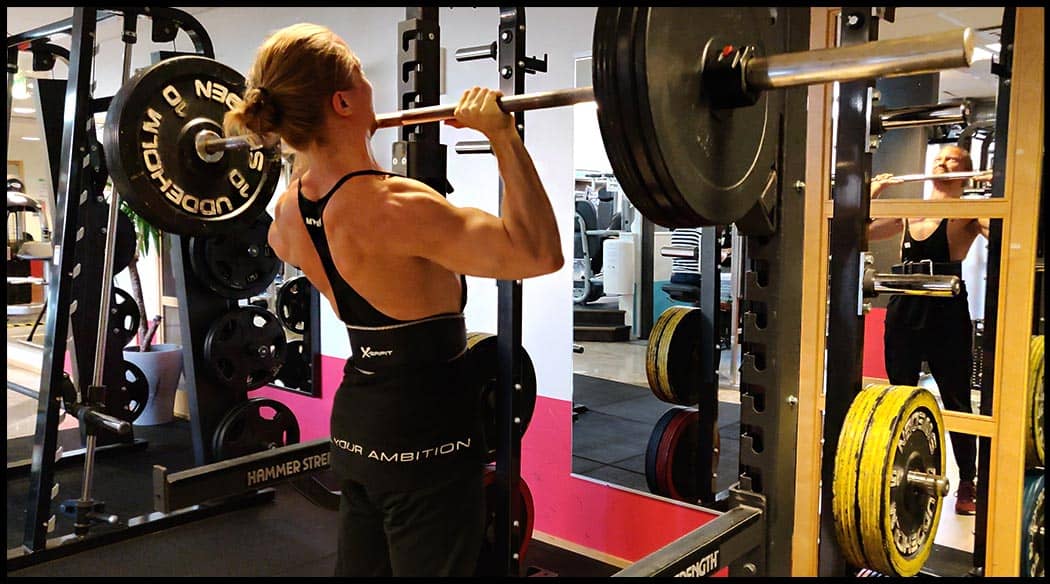
Training almost exclusively with big compound exercises are hands down the most optimal and effective way to build a great looking lean and muscular physique.
It’s been shown repeatedly that nothing beats the effectiveness of doing compound lifts for strength and physique development. This is simply because:
- You can lift the most amount of weight with compound lifts.
- It stresses the whole body as one.
- You can go through a full range of motion that is very natural to the body.
Another very important reasons to use all the big compound exercises, is to create a physique that’s symmetrical and proportional.
As I just mentioned, by doing large compound lifts, you make sure your body gets developed as one, and this is crucial when building your physique, especially during your beginner to intermediate stages.
Here are the 7 exercises that should ideally be included in your training program:
The Most Bang For Your Buck Exercises
First, we got the big four – Which are our main strength and muscle growth drivers, and these are:
- Bench Press (barbell and dumbbell)
- Overhead Press (barbell and dumbbell)
- Squats (Leg press if you’re not built for squatting)
- Deadlifts, regular or Romanian
Then we also have what I call our supplemental compound lifts – And these are in place to build the right proportions, and these are:
- Weighted Pull-ups (Pulldowns if you can’t do Pull-ups)
- Cable Rows (wide grip and close grip)
- Incline Bench Press (barbell and dumbbell)
All the exercises you see above, except for a few isolation exercises which we’ll look at in a moment, are all you need to build an aesthetic physique.
Strategy #3 – Train In The 5-12 Rep Range
I’ve heard that the rep range doesn’t matter that much for muscle growth?
Well, that’s actually true, the rep range doesn’t matter that much for muscle growth directly. If you get stronger over time with any rep range, you will build muscle.
However, building muscle will be a lot harder to do outside of the 5-12 rep range.
Here’s why:
By training with 5-12 reps you will achieve the perfect balance between effectively getting in enough training volume, while still working with heavy enough weights to maximize mechanical tension on the muscles, which are a key factor to more quickly and conveniently achieve muscle growth.
Training with weights that are heavy which stimulates more mechanical tension (stretching and contracting under load) than metabolic fatigue (the pump) is very beneficial if you’re looking to get the most bang for your buck.
In fact, if you were to focus all your energy on high rep, low load training, you would have to take all your sets to the point of failure to get the same effects on muscle growth that you would from sticking with fewer reps and heavier weights.
In one study they tried to get the same stimulus for growth as you would from lower reps, using higher reps. The participants constantly felt nausea during the workout, and some even threw up from all the lactate that was built up to achieve the stimulus. That doesn’t sound enjoyable to me…
So, it’s much more effective to train with strength in mind, which is to go for between 5-12 reps on most of your lifts, as this will make your workouts a lot more effective and enjoyable.
Furthermore, what makes the 5-12 rep range so great is that it’s not too heavy either. If you were to train with lower reps than five, you would need to do more total sets to reach the same volume threshold to create a good enough stimulus for growth.
This is in many cases not sustainable either, since a lot of sets with very heavy weights is more demanding on your joints, ligaments and central nervous system, rather than on your muscles.
Finally, the 5-12 rep range is also the easiest to make progressive overload in, which means making your training harder over time. And there’s two reasons for that:
- It’s very easy to keep track of your workouts and weights, because you can typically make larger leaps in weight which are easier to track. And tracking is key behind successful progressive overload.
- Lots of people find it more enjoyable moving heavier rather than lighter weights, and enjoyment to training should definitely not be taken for granted, as it’s been shown repeatedly that aroused lifting cause more gains than merely going through the motion in the gym.
As you can see working in the 5-12 rep range comes with a bunch of advantages. And if you haven’t trained much in this rep range before, be ready to experience a lot of strength gains followed by new muscle mass once you get started.
Rest Times:
Okay, so the rest times for your compound lifts within the 5-12 rep range should be between 3-5 minutes. This time will be required to ensure that you are fresh and ready to perform your best on each set.
Strategy #4 – Add A Few Key Isolation Exercises And Use MYO-Reps
The main reason why we need to use isolation exercises is because there’s one muscle in particular that needs to be isolated in order to be trained. If you don’t isolate it, it will be underdeveloped.
And that’s your medial delts.
If you leave your medial delts underdeveloped, you will lose out on a huge part of what makes up an an aesthetic physique.
The problem with your medial delts is that they’re used in a certain way that doesn’t let them get hit effectively by any of your compound lifts, not even overhead presses hit you medial delts enough.
The only way to effectively hit them is when you extend your arms out to the sides, like if you were standing with your side against a wall and pushing your arm against it, like this:
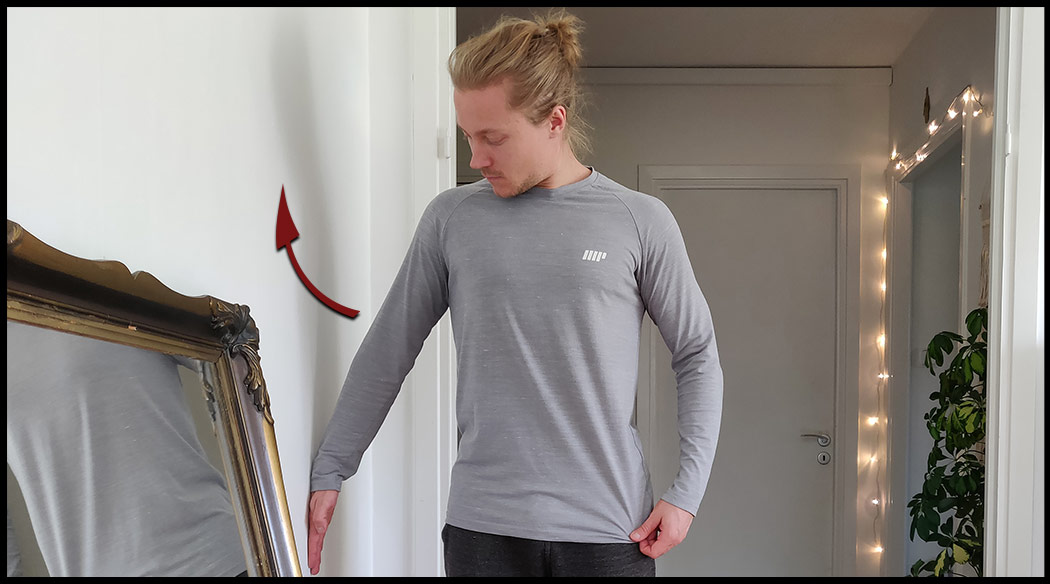
This movement puts your shoulders in a very bad position to lift heavy weights, risking injury. For that reason, you need to use isolation exercises, with lighter weights and higher reps to train your side delts safely and effectively.
Another reason for using isolation exercises are for certain muscle groups that needs a bit more volume to grow. Typically for most people, this would be biceps and rear delts, which are also huge components of an aesthetic physique.
Most people will get decent bicep and rear delt growth from compound lifts like pull-ups and rows. But to get very well-developed biceps and rear delts, these muscles typically require a bit more work. Simply because they’re very fatigue resistant.
And if you were to do that extra work with compound lifts, you would risk overtraining other muscles included in the lift, such as the Lats, Rombs and Traps etc.
Another muscle group that should be trained with isolation exercises, are the one who people think are made in the kitchen.
Yes, you guessed it, I’m talking about your abs!
Here’s the thing:
Abs are revealed in the kitchen, but just as with any other muscle, they’re built in the gym.
Now, heavy compound lifts will train your abs. But they will mainly train your internal, stabilizing abs, such as your transverse abdominis, and your internal obliques.
To get that six pack to really pop when you’re lean, you must train your rectus abdominis directly, which is done with ab flexion exercises, such as crunches, and leg raises for example.
So, here are the 4 ideal exercises that’ll ensure you’re developing your medial delts, rear delts, biceps and abs completely:
Complete Development Isolation Exercises
- Dumbbell Lateral Raises
- Rear Delt Dumbbell Flyes
- Dumbbell or Barbell Spider Curls
- Hanging Leg or Knee Raises
Okay, so to add this extra work for these specific muscles without drastically increasing the time and effort required, I’ve found an extremely effective and enjoyable strategy to use, which is called:
Myo-Reps
Myo-reps take advantage of rest periods to give you the same training stimulus in around two thirds of the time it would normally take you, and it also leaves you with an incredible pump.
And here’s how you do Myo-reps:
Myo-Reps Guidelines
- Start by doing an activation set: Use a weight that you can get between 12-15 reps with. Then do as many reps as you can until you’re 1-2 repetitions away from failure.
- After the activation set, rest 10-15 seconds
- After the short rest do another set until you’re 1-2 reps away from failure.
- Then rest another 10-15 seconds
- Repeat this process until you no longer can get the same amount of reps on all your “minisets”, stop after you’ve reached 5 sets in total.
The power of Myo-Reps is that it’s a highly effective way to get a lot of work done in a short period of time.
Because of the short rest times, each “miniset” will have you work with repetitions that will cause muscle growth immediately.
Think of it this way, if you were to do 12 to 15 reps the standard way, meaning with 1 to 2 min rest in between. Then the first 8-10 reps of the exercise are going to be so easy that you would just go through the motion and not actually get any productive work from the time and movement invested.
Like displayed under high reps/low load in this image:
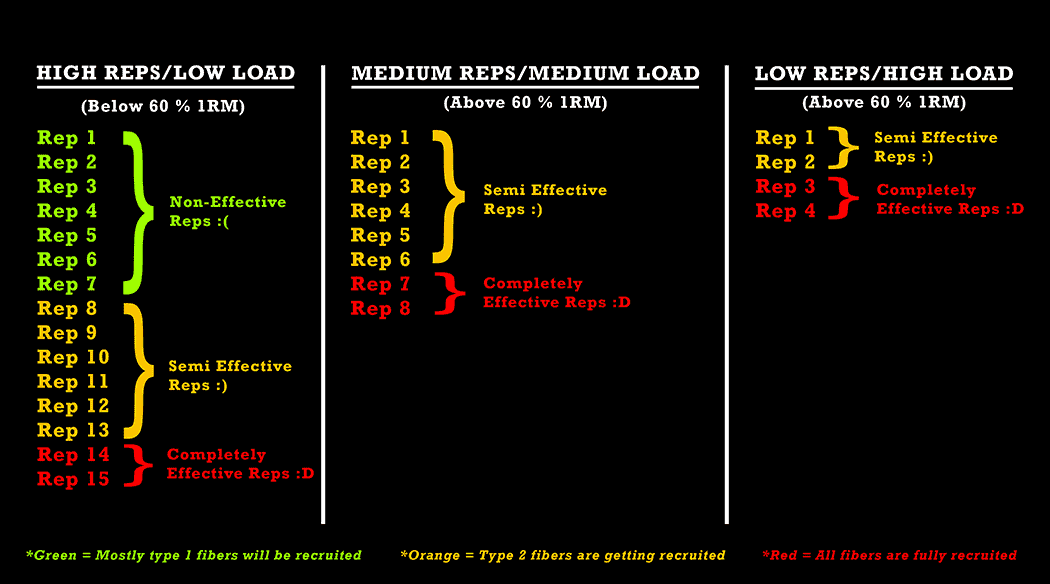
With Myo-reps on the other hand, since you’re utilizing shorter rest periods, each miniset would be like starting on rep 8-10, meaning that immediately from the first rep you do effective work that causes muscle growth.
If you want to learn more about the benefits and how to do Myo reps, then I recommend that you check out the complete Myo reps guide here.
What About Cardio?
Cardio can be summed up in one sentence:
It’s not required to do cardio to build a lean and muscular physique.
In fact, if your goal is to get lean, muscular and healthy, doing more than 2 hours of cardio per week is completely unnecessary.
Here’s the thing:
I’ve helped a lot of people get lean and muscular.
And everyone who’s done more than 2 hours of cardio per week before working with me, has achieved great results when it comes to their physique from bringing down the cardio.
Why is this?
Well, because most cardio modalities strongly activates endurance developing pathways within the muscle cells. What this does is reducing the strength and muscle development pathways.
In other words, you reduce your bodies ability to build muscle and strength by doing to much cardio activity.
Not only that, cardio also steals a lot of energy and recovery that could go towards doing productive and effective strength training workouts instead.
But won’t cardio help me burn fat?
Yes it will, but the diet do so a lot more effectively without impairing strength and muscle development as negatively.
In fact, 1 hour on the treadmill at a moderately high intensity equals around 500 calories burned. That’s nothing for so much time and recovery capacity invested. So, if your goal is fat loss, it’s much better to reduce calories via the diet.
If that’s not all, too much cardio typically spikes hunger for a lot of people. This is a response made by the body to compensate for the lost energy. And it’s not uncommon that people end up eating more energy from this response than what they burned of during the cardio itself.
This however isn’t true if you control your diet by counting your calories and macros, but you’ll still have to fight increased hunger.
Finally, if you want to be able to spend very little time on your training, while still getting great results, cardio is simply not worth looking into.
With that said however, I do recommend that you do some cardio for health reasons and also when bulking, which you can read about here.
If you choose to do cardio, here are my recommendations:
Cardio Recommendations:
Choice #1 – Do “lifestyle” cardio like walking and cycling etc.
This is low intensity cardio, that doesn’t activate endurance pathways nor does it steal from recovery, while it at the same time help burn more calories. And best of all, it do so without signaling hunger.
This is also great for health, in fact, it’s been shown that you should walk at least 10.000 steps per day to stay healthy.
Choice #2 – Do 1 max 2 sessions of HIIT or alike.
I recommend 8-12 minute intervals. Cardio workouts like this is very similar to pump training with weights, and it promotes muscle growth. However, doing to much of it and you will overtax your capacity to recovery. One plus with this kind of cardio, is that it’s short, meaning you get more time to do other things.
Best health wise, would be to do a combination of both.
BONUS: Example Training Routines
Okay, so let’s put everything that we’ve learned around training together. Here are a few example minimalist training routines that’ll give you the most bang for your buck in the gym:
Beginner Routine
This is a good routine for your first 6-12 months of training.
Workout A – Upper Body
- Flat Bench Press – 5 sets of 6-8 reps
- Weighted Chins – 5 sets of 6-8 reps
- Standing Overhead Press – 3 sets of 8-10 reps
- Cable Rows – 3 sets of 8-10 reps
- Dumbbell Lateral Raises – MYO-Reps 12-15
- Dumbbell or Barbell Spider Curls – MYO-Reps 12-15
Workout B – Lower Body
- Barbell Squats – 5 sets of 6-8 reps
- Romanian Deadlift – 3 sets of 6-8 reps
- Leg Press – 3 sets of 8-10 reps
- Hanging Leg or Knee Raises – MYO-Reps 12-15
Beginner Progression Model
- Alternate between the 3 workouts on non-consecutive days. For example:
- Monday – Workout A
- Wednesday – Workout B
- Friday – Workout A
- Monday – Workout B
- When you hit the required reps for all sets, increase the weight with 2.5 kg (5 lbs) on all sets the following workout. If you lose a few reps on the upcoming workout, no worries. Your goal for the following workout is to add back the reps in those last sets so you can increase the weight once again.
- Use a lifting app or paper to track your progress.
Novice to Intermediate Routine
Transition into this routine once you no longer are able to make progress on the beginner routine.
Below you’ll find a 4 day routine, that can be scaled to three days by removing one of your leg days, and instead do more on the one remaining leg day. However, I’ve found this to give a ton of soreness and DOMS, that’s why I like doing legs twice per week.
Monday – Upper Body – Chest Emphasis
- Flat Bench Press – 5 sets of 6-8 reps
- Cable Rows – 5 sets of 6-8 reps
- Incline Bench Press – 3 sets of 8-10 reps
- Seated Shoulder Press – 3 sets of 8-10 reps
- Rear Delt Dumbbell Flyes – MYO-Reps 12-15
- Dumbbell or Barbell Spider Curls – MYO-Reps 12-15
Tuesday – Lower Body A
- Barbell Squats – 4 sets of 6-8 reps
- Romanian Deadlift – 3 sets of 6-8 reps
- Leg Press – 4 sets of 8-10 reps
- Hanging Knee/Leg Raises – MYO-Reps 12-15
Thursday – Upper Body – Back & Shoulder Emphasis
- Weighted Pull Ups – 5 sets of 6-8 reps
- Standing Barbell Shoulder Press – 5 sets of 6-8 reps
- Cable Rows – 3 sets of 8-10 reps
- Incline Bench Press – 5 sets of 8-10 reps
- Dumbbell Lateral Raises – MYO-Reps 12-15
- Dumbbell or Barbell Spider Curls – MYO-Reps 12-15
Friday – Lower Body B
- Regular Deadlifts – 4 sets of 6-8 reps
- Barbell Squats – 4 sets of 6-8 reps
- Leg Press – 3 sets of 8-10 reps
- Hanging Knee/Leg Raises – MYO-Reps 12-15
Novice To Intermediate Progression Model
- When you hit the required reps for all sets, increase the weight with 2.5 kg (5 lbs) on all sets the following workout. If you lose a few reps on the upcoming workout, no worries. Your goal for the following workout is to add back the reps in those last sets so you can increase the weight once again.
- Use a lifting app or paper to track your progress.
 What’s Your Thoughts?
What’s Your Thoughts?
Okay, so there we go, the complete dieting and training system that will get you lean, muscular and healthy, while allowing you to live your life to the fullest in the meantime.
Now I want to leave it to you, what’s your take on this training and dieting system?
Do you have the goal to get lean and muscular, but you don’t want to give up on your life in the process?
Let me know what you think down in the comments, right now!
What’s Next?
If you’re still wondering what you should do, then I recommend that you read the guide: How to build an aesthetic physique. In that guide you’ll learn exactly the steps you need to take to get lean and muscular depending on your starting point and goal.

Can you please make a post on how to progress with myo reps? thanks
Yes, I’m actually working on a myo reps post as we speak, it’ll be out within a week!
Hey again Elio, I just finished a complete guide about Myo reps where you can learn how to progress with the method. Here’s a link to the guide: https://www.ironbuiltfitness.com/myo-reps-for-extra-gains
Have a great day!
Thank you for this very informative post. I have been doing intermittent fasting for a couple of weeks now and Ive immediately seen the results from this diet. I also plan my meal ahead of time so that I dont overeat nor eat food that is not healthy for me.
Hi Niklas. Your website is awesome! Thanks for all the great information, it really helps! I’m going to start intermittent fasting on Monday and follow everything you’ve said. I’m also going to use the novice to intermediate routine that you’ve got above, as I’ve been working out for quite a long time. I just had a question. On the second upper body day, is it definitely meant to be 5 sets on incline bench press or should it be 3 sets? Also, I’ve been doing my own thing for a long time and have developed big arms, but I still have small shoulders. Not a good look! Do you have any advice for correcting this, or do you think if I follow your routine above it should correct itself naturally? Thanks.
Hi Chris, thanks! Awesome, let me know how it goes for you and if you have any questions along the way! Yep it’s meant to be 5 sets, this is because intermediates in most cases require a bit more volume to grow, so aiming for around 12-15 sets on all muscle groups per weeks usually works very well. However, if you haven’t done close to this volume in your training so far, then go with 3 sets instead, otherwise you might do too much volume too soon. Regarding your arms to shoulder ratio, I recommend that you do the routine as it is for now since it includes a lot of pressing movements which will target your shoulders a lot. If you’re not seeing results on your shoulders in a few months, reach out to me! 🙂
Brilliant, I’ll definitely do the 5 sets then. Thanks for all your advice it really helps! I’ll keep you posted on my results 🙂